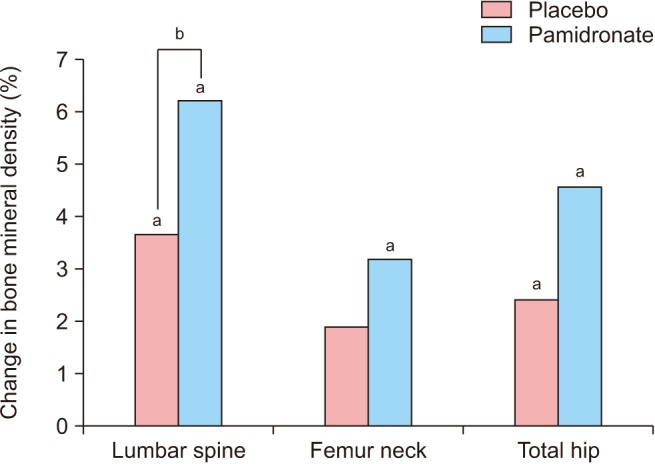J Menopausal Med.
2019 Dec;25(3):117-122. 10.6118/jmm.19198.
Effects of Adding Intravenous Pamidronate to Ongoing Menopausal Hormone Therapy in Postmenopausal Korean Women with Low Bone Mineral Density
- Affiliations
-
- 1Department of Obstetrics, Gynecology and Women's Health, Samsung Medical Center, Sungkyunkwan University School of Medicine, Seoul, Korea. bkyoon@skku.edu
- KMID: 2466826
- DOI: http://doi.org/10.6118/jmm.19198
Abstract
OBJECTIVES
We evaluated the effects of adding intravenous pamidronate to ongoing menopausal hormone therapy (MHT) on bone mineral density (BMD) in postmenopausal Korean women with low BMD.
METHODS
This retrospective cohort study included 74 postmenopausal women who received MHT for at least 1 year and had a BMD T-score of less than −2.0. Maintaining the same MHT regimen, these women were divided into two groups: oral placebo group (n = 44) and a pamidronate group of patients with gastrointestinal discomfort (n = 30) who received 15-30 mg pamidronate intravenously every 3-12 months. BMD was reviewed at 12-month follow-up. Bone resorption markers in both groups, urinary deoxypyridinoline levels in the placebo group, and serum N-telopeptide of type I collagen in the pamidronate group were assessed at 6 and 12 months.
RESULTS
At baseline, the body mass index (BMI), duration of previous MHT, and femur neck (FN) BMD differed between the groups. Within-group analysis revealed that BMD of the lumbar spine (LS) and total hip (TH) significantly increased in the placebo group, whereas those of the LS, FN, and TH increased in the pamidronate group. The increase in BMD of LS was significantly greater in the pamidronate group, after adjusting for BMI and duration of previous MHT (mean change: 3.7% vs. 6.2%; P < 0.001). There were no changes in bone resorption markers in either group.
CONCLUSIONS
Adding intravenous pamidronate to ongoing MHT for 12 months might increase LS BMD in postmenopausal Korean women with low BMD.
MeSH Terms
Figure
Reference
-
1. Effects of hormone therapy on bone mineral density: results from the postmenopausal estrogen/progestin interventions (PEPI) trial. The Writing Group for the PEPI. JAMA. 1996; 276:1389–1396. PMID: 8892713.2. Nelson HD, Rizzo J, Harris E, Cauley J, Ensrud K, Bauer DC, et al. Osteoporosis and fractures in postmenopausal women using estrogen. Arch Intern Med. 2002; 162:2278–2284. PMID: 12418942.
Article3. Hillard TC, Whitcroft SJ, Marsh MS, Ellerington MC, Lees B, Whitehead MI, et al. Long-term effects of transdermal and oral hormone replacement therapy on postmenopausal bone loss. Osteoporos Int. 1994; 4:341–348. PMID: 7696830.
Article4. Fleisch H. Bisphosphonates: mechanisms of action. Endocr Rev. 1998; 19:80–100. PMID: 9494781.
Article5. Black DM, Cummings SR, Karpf DB, Cauley JA, Thompson DE, Nevitt MC, et al. Randomised trial of effect of alendronate on risk of fracture in women with existing vertebral fractures. Fracture Intervention Trial Research Group. Lancet. 1996; 348:1535–1541. PMID: 8950879.6. Liberman UA, Weiss SR, Bröll J, Minne HW, Quan H, Bell NH, et al. Effect of oral alendronate on bone mineral density and the incidence of fractures in postmenopausal osteoporosis. The Alendronate Phase III Osteoporosis Treatment Study Group. N Engl J Med. 1995; 333:1437–1443. PMID: 7477143.7. McClung MR, Geusens P, Miller PD, Zippel H, Bensen WG, Roux C, et al. Effect of risedronate on the risk of hip fracture in elderly women. Hip Intervention Program Study Group. N Engl J Med. 2001; 344:333–340. PMID: 11172164.8. Boonen S, Laan RF, Barton IP, Watts NB. Effect of osteoporosis treatments on risk of non-vertebral fractures: review and meta-0analysis of intention-to-treat studies. Osteoporos Int. 2005; 16:1291–1298. PMID: 15986101.9. Harris ST, Eriksen EF, Davidson M, Ettinger MP, Moffett AH Jr, Baylink DJ, et al. Effect of combined risedronate and hormone replacement therapies on bone mineral density in postmenopausal women. J Clin Endocrinol Metab. 2001; 86:1890–1897. PMID: 11344179.
Article10. Min YK, Lee DY, Choi SJ, Kim JH, Choi D, Yoon BK. Effects of adding alendronate to ongoing hormone therapy on bone mineral density in postmenopausal Korean women: a randomized, double-blind, placebo-controlled clinical trial. Menopause. 2013; 20:761–766. PMID: 23403498.11. Aki S, Eskiyurt N, Akarirmak U, Tüzün F, Eryavuz M, Alper S, et al. Gastrointestinal side effect profile due to the use of alendronate in the treatment of osteoporosis. Yonsei Med J. 2003; 44:961–967. PMID: 14703602.
Article12. Anckaert E, Öktem M, Thies A, Cohen-Bacrie M, Daan NM, Schiettecatte J, et al. Multicenter analytical performance evaluation of a fully automated anti-Müllerian hormone assay and reference interval determination. Clin Biochem. 2016; 49:260–267. PMID: 26500002.
Article13. Reid IR, Wattie DJ, Evans MC, Gamble GD, Stapleton JP, Cornish J. Continuous therapy with pamidronate, a potent bisphosphonate, in postmenopausal osteoporosis. J Clin Endocrinol Metab. 1994; 79:1595–1599. PMID: 7989461.
Article14. Brumsen C, Papapoulos SE, Lips P, Geelhoed-Duijvestijn PH, Hamdy NA, Landman JO, et al. Daily oral pamidronate in women and men with osteoporosis: a 3-year randomized placebo-controlled clinical trial with a 2-year open extension. J Bone Miner Res. 2002; 17:1057–1064. PMID: 12054161.
Article15. Vis M, Bultink IE, Dijkmans BA, Lems WF. The effect of intravenous pamidronate versus oral alendronate on bone mineral density in patients with osteoporosis. Osteoporos Int. 2005; 16:1432–1435. PMID: 15883662.
Article16. Kang M. Bisphosphonate. The Korean Society for Bone Mineral Research. Textbook of osteoporosis. 5th ed. Seoul: Koonja;2016. p. 253–265.
- Full Text Links
- Actions
-
Cited
- CITED
-
- Close
- Share
- Similar articles
-
- The Effect of Hormone Replacement Therapy on Bone Mineral Density in Postmenopausal Women
- Hormone Therapy in Postmenopausal Women According to the Correlation of Changes in Bone Mineral Density
- Pamidronate Treatment in Vertebral Fracture after Off-therapy of Medulloblastoma
- Awareness and Experience of Menopausal Symptom and Hormone Therapy in Korean Postmenopausal Women
- A Comparison of the effect of Synthetic Hormone Replacement therapy on Bone Mineral Density and Biochemical markers of Bone metabolism


